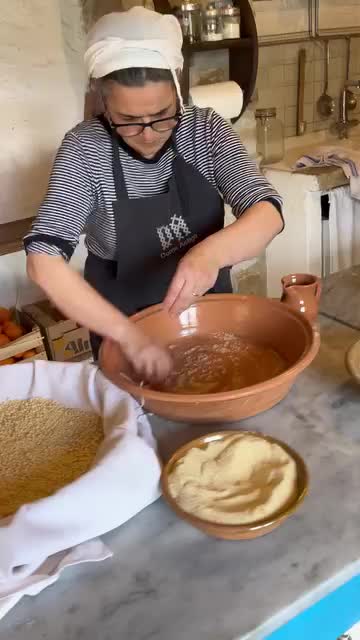Copy Link
Add to Bookmark
Report
Mead Lovers Digest #0585

Subject: Mead Lover's Digest #585, 14 August 1997
From: mead-request@talisman.com
Mead Lover's Digest #585 14 August 1997
Forum for Discussion of Mead Making and Consuming
Dick Dunn, Digest Janitor
Contents:
Mead Ale (Mike Ross)
Destoning Cherries (DFusion@aol.com)
Re: Mead Lover's Digest #584, 11 August 1997 (Thaddaeus A Vick)
Re: Mead Lover's Digest #584, 11 August 1997 ("Jack Rickard")
Re:sweet mead (PickleMan)
Chyerries, Cherry Juice (Ken Schramm)
When to Sanitize Fruits (Katydidit@aol.com)
sweet mead..., a reply to Charlie (Mark Koopman)
Matt M. made me go Bananas ("Linda or Darin")
Pasteurization, starters (Samuel Mize)
LONG primary fermentation ("Jeff M. Ashley")
NOTE: Digest only appears when there is enough material to send one.
Send ONLY articles for the digest to mead@talisman.com.
Use mead-request@talisman.com for [un]subscribe/admin requests. When
subscribing, please include name and email address in body of message.
Digest archives and FAQ are available for anonymous ftp at ftp.stanford.edu
in pub/clubs/homebrew/mead.
----------------------------------------------------------------------
Subject: Mead Ale
From: mross@tgf.tc.faa.gov (Mike Ross)
Date: Mon, 11 Aug 1997 14:07:16 -0400
Hi Ya All,
Thanks for the response to my Mead Ale request. It gives me hope that I
will oneday achieve true, Mead Ale.
The first results are in from my first attempt.
The good news;
It is a lovely champagne color with a nice head. The bottle carbonation
worked great as usual so pouring it looks like your in for a treat.
The bad news;
The taste is well, lacking. You get a faint trace of hops, little to
no taste of honey, I have tried meads made by others and there was no
resemblance. It was sorta like a honey spritzer or maybe a weak ZIMA,
apologies to those who may actually like ZIMA, whoops, sorry again.
Well you get the idea, insipid is an accurate description. Maybe
after aging some more it will be better, kinda doubt it though.
Oh, well I'll keep trying to find that perfect receipe.
See Ya,
Mike Ross
------------------------------
Subject: Destoning Cherries
From: DFusion@aol.com
Date: Mon, 11 Aug 1997 16:02:46 -0400 (EDT)
Hello everyone-
I just made a blackberry-cherry mel. I didn't think until after the fact
that cherry stones contain poision. I left the fruit (stones and all) in the
primary for about a week. Does anyone know if I made poision mead? Thanks
for the help.
Dave
------------------------------
Subject: Re: Mead Lover's Digest #584, 11 August 1997
From: barefoothugh@juno.com (Thaddaeus A Vick)
Date: Mon, 11 Aug 1997 18:59:42 -0400
>Subject: Re: Mead Lover's Digest #583, 8 August 1997
>From: Charles Hudak <cwhudak@mail.adnc.com>
>Date: Sat, 09 Aug 1997 09:55:50 -0700
>
>Re: Is it stuck, or just finished?
>
>Thaddaeus, you didn't mention what type of yeast that you used.
>A Champagne yeast would normally have quite a bit higher attenuation
than
>you've gotten. An ale yeast on the other hand....hey maybe you can tell
me
>where you picked that up, I've got some strong ales I'd like to make
with
>that yeast.
You're right, I should have mentioned. It was Red Star Premier
Cuvee, which
I used because that's what the proprietor of the homebrew shop
recommended.
>Seriously, it very much depends on the typical attenuation that that
yeast
>gives. You've only been fermenting for two weeks though!! Relax!! Let
it
>sit for several more MONTHS! I have meads in tertiary that I made four
>months ago. When it clears, wait a while longer then bottle; it should
be
>just fine.
Yes, but I knew it would ferment out faster than a regular batch,
because it
was only one gallon instead of five. The trouble was that I didn't know
how
much faster it would finish, and 1.010 is a pretty low SG, so it might be
done.
- ----------------------------------------------
Thaddaeus A. Vick
dvick@crl.com --or-- BarefootHugh@juno.com
http://www.crl.com/~dvick
------------------------------
Subject: Re: Mead Lover's Digest #584, 11 August 1997
From: "Jack Rickard" <jack.rickard@boardwatch.com>
Date: Mon, 11 Aug 1997 18:58:53 -0600
> I purchased 15 lbs. of raw wildfower honey, in this case mostly clover
> and blackberry, from a local bee keeper for $1.25 lb ( good price,
> I'm told ). I boiled 3 gallons of water. Removed the pot from the heat
> and stirred in 13 lbs. of honey until dissolved. I then added 3 lbs.
> frozen raspberries and 4 lbs. of fresh frozen diced peaches. This
> brought the temp down to 120F. I turned heat back on and raised
> the heat back up to 150F, where I pasteurized the must ( must is to
> wine/mead as wort is to beer) for 30 minutes while the temperature
> slowly rose to 160F. I cooled the must with an immersion chiller, to
> around 95F. Dumped the whole mess into my carboy. Rehydrated
> a pack of Red Star dry champagne yeast in 1/4 cup boiled water at
> 95F. Aerated the must in the carboy by the brute force method, and
> pitched the yeast after the must had cooled to about 85F.
>
> It is now fermenting along happily at about 75F with about 30 bubbles
> per minute.
>
> Any thoughts or comments on my recipe/method are greatly appreciated.
> Sorry for the waste of bandwidth for you hard-core brewers. I will be
> posting future mead questions to the Mead Lovers Digest.
>
Shaun:
Just a couple of comments. 15 lbs in 3 gallons will make a rather stout
mead I would think - around 4 pounds of honey per gallon will put you way
up over 1.120. But whatever. I almost never heat fruit. Sometimes I'll
mash up the fruit, cool the pasteurized must to about 120, and drop it on
top, but I just never heat it directly. The reason is that many fruits,
particularly apricots and so forth give off a bit of pectin. The peaches
are kind of bad about that, though berries really don't put out much.
Heating accentuates this. Pectin is a natural product of fruit and you
might note that to make jams and jellies, often all you have to do is cook
the fruit a bit and let it set.
The reason this is important is that I've had excellent experience with
meads clearing to crystal clear EXCEPT when using fruits in them. I think
pectin is the culprit, it hazes and never seems to want to clear later.
In addition to not heating fruit any more than necessary, I also add 1/2 oz
pectic enzyme per 5 gallons of anything with fruit in it - usually as soon
as the must has cooled to 85 degrees or below. Pectic Enzyme converts the
pectin to solids which then drop to the bottom allowing the mead to clear
later.
Fortunately, it works about any time. I had an apricot/canteloupe melomel
that just wouldn't drop. Added 1/2 oz of pectic enzyme and it was clearing
nicely within a week.
Note that I've had very limited success with sparkaloid or bentonite on
pectin based hazes.
So for what it's worth, no fruit heating (it's different from grain) and
pectic enzyme with anything that has ANY fruit in it.
My two cents.
Jack Rickard
===================================================================
Jack Rickard Boardwatch Magazine
Editor/Publisher 8500 West Bowles Ave., Ste. 210
jack.rickard@boardwatch.com Littleton, CO 80123
www.boardwatch.com Voice: (303)973-6038
===================================================================
------------------------------
Subject: Re:sweet mead
From: PickleMan <wrp2@axe.humboldt.edu>
Date: Mon, 11 Aug 1997 21:10:24 -0700 (PDT)
How large was your starter? I made a 1/2 gallon starter and
initial fermentation took off like a shot. However, 2' fermentation seems
to be dragging on forever. I started July 1st with 12 lbs. of honey
(nutrient, etc.) and it's still lazily bubbling once every 20 secs or so.
It is getting clearer, and I suspect it will be adequately brite as soon
as it stops fermenting and I have a chance to chill it. I think it would
go faster if I regulated the pH, but I'm in no hurry.
PickleMan
wrp2@axe.humboldt.edu
------------------------------
Subject: Chyerries, Cherry Juice
From: Ken Schramm <SchramK@wcresa.k12.mi.us>
Date: Tue, 12 Aug 1997 10:09:24 -0400
In response to the two posts about cherries, go for it on both
counts.
I have made a mead from post secondary addition of cherries and from
use of cherry juice in the must. It turned out to my liking, but the
cherries post secondary yielded a slight oxidative note which has
continued to diminish with age (suprisingly). With the juice, I used
3 gallons in the must, and then I added the cherries to the carboy 2
lbs at a time until I achieved the desired amount of cherry flavor.
I would suspect that either method by itself would make for a very
acceptable batch of cherry mead.
As for mine, it has a powerful cherry flavor and nose. I wouldn't
recommend any acid blend here; the cherries add plenty of tartness by
themselves. As for the Q about sweet -v- dry, my own bent would lean
toward using sweet cherries in dry meads, ands tart cherries in sweet
meads, to provide a juxtaposition of acidity, sweetness and fruit
flavor.
But who am I to blow against the wind? (Paul Simon)
Schramm
------------------------------
Subject: When to Sanitize Fruits
From: Katydidit@aol.com
Date: Tue, 12 Aug 1997 11:00:43 -0400 (EDT)
Hello to all, newbie here --
I'm trying to take all my melomel-making preparations one at a time and
am due to purchase my fruits this weekend and plan to freeze until ready. I
have read that it can be beneficial to not include the fruit in the must but
to rack onto the pulverized fruit after the initial fermentation. Does
anybody have a more experienced argument against this technique?
Secondly, I would prefer not to boil/heat the fruit when ready, but to
sanitize it with sulphites instead (1 tablet or 0.04 grams per gallon).
Again, does anybody have a valid argument against this technique?
My follow-up questions, then, are these:
(1) If I am not going to prepare the fruit along with the must, when do I
treat the fruits with sulphites -- at the intial prep (before freezing) or at
the time of thaw and pulverization?
(2) If I am going to sanitize the fruit via sulphites rather than
pasteurization, are there any advisements against sanitizing the must in the
same way (i.e., sodium metabisulphite rather than boiling)?
Your digests, archives, and web sites have been invaluable. Thanks to all
for the past and future. Wassail !
Kathleen Hubbard
Katydidit@aol.com
------------------------------
Subject: sweet mead..., a reply to Charlie
From: Mark Koopman <mkoopman@earthlink.net>
Date: Tue, 12 Aug 1997 17:05:07 -0500
Charlie wrote:
"Greetings, I am new to this list but an old hand at brewing and mead
making. Until recently, I have limited myself to dry meads and
metheglins. In February of this year, I finally tried a sweet mead -
using Wyeast 3184 (sweet mead) yeast in a starter. Fermentation started
as expected but seems stuck - I mean really stuck. I know that 6 months
is still early, but I haven't seen any activity for a couple of months
and there is absolutely no clearing. I have not racked to a secondary
nor have I taken any intermediate gravity readings (afraid of
infection/oxidation).
This culture is new to me but I've since been told that this is common
for this strain and that it may never clear!! I am patient, but
worried. Looking for advice - add another yeast?"
This yeast gets a lot of flack on the MLD, and some of it justified.
Since its one of my favorites, I'll try to help. If you have a wine
thief, take a sample and buy or borrow a Ph meter. Take both gravity
and Ph from the sample. This yeast will only ferment out 8-11% alcohol,
and is sensitive to Ph below about 3.6, or so. My experience has been
that the alcohol tolerance is not as consistant as one would like, so it
helps to add honey as fermentation goes along to get the sweetness you
want.
The good news is: it may very well be finished! The even better news
(and one of my very favorite things about the yeast) is that it almost
always tastes great through the entire process, including at bottling
time. The sweeter meads preserve much more of the flavor of the honey,
although many would disagree with this. Its all a matter of taste. I
also highly reccommend blending at drinking time with some of your dry
stock. Its fun, and everyone at the table can blend to their own taste.
mark koopman
------------------------------
Subject: Matt M. made me go Bananas
From: "Linda or Darin" <mtss@ptw.com>
Date: Tue, 12 Aug 1997 21:39:21 -0700
In MLD #575, Matt Maples gave a recipe for a banana melomel, for which I
thank him. Actually, what I want to thank him for, is the insight of
boiling the sliced bananas in a bag. In sixth grade, they called it an
"Ah-ha insight." It's one of those concepts that, once you know it, you
can't believe you hadn't figured it out before.
So, anyway, I wanted to learn about bananas, so I streamlined the recipe a
bit as follows:
3# bananas, boiled in a bag for 1/2 hour, bag & contents discarded
3# local honey
water to 1g
Lalvin D47 starter
OG: 1.085
I racked it at 13 days, and the gravity was basically 1.000, so I added
1/2# more honey. 18 days later, I racked again, this time the gravity was
about 1.005. It tasted young and hot, (of course,) but I liked the ammount
of banana. It didn't knock me over, but there was no doubt what kind of
melomel it was. I'll pass on my final judgement next year. I still can't
decide if I want it to be sweet or dry, so I will just have to keep
experimenting ;-}
Darin Trueblood
------------------------------
Subject: Pasteurization, starters
From: Samuel Mize <smize@prime.imagin.net>
Date: Wed, 13 Aug 1997 15:12:00 -0500 (CDT)
Greetings to all, and especially to these fine folk who wrote in Mead
Lover's Digest #582:
> Subject: Metheglin and molasses
> From: nkanous@tir.com (nkanous)
> Second (or maybe third), most of these spices are similar to what is
> included in one of my personal favorites, molasses cookies! Anybody
> experimented with molasses in meads / metheglins? Thanks
Molasses gets used in beer, especially in stouts. According to an
article from Southwest Brewing News, it adds a rich, rummy, buttery
character, but is harsh if used to excess -- more than 8 oz to a
5 gallon batch.
> Subject: First meads
> From: jwilkins@imtn.tpd.dsccc.com (John Wilkinson)
> I boiled the previous batches but have seen it
> recommended that the honey not be boiled to prevent driving off too much
> flavor. I will probably try this. How about fruit? I understand that I
> may have problems clearing. Do I use pectin or some enzyme to help reduce
> the pulp?
(I have read) if you boil fruit, it will start to gel, making it hard
to clarify. This is from release of pectin, so adding pectin won't help.
However, I would recommend pasteurizing the fruit. Honey has natural
characteristics that resist bacteria and wild yeast, fruit does not.
To pasteurize, crush the fruit, put it into some water, and heat it to
150 for 20 minutes, or to 170 for 5 minutes. (I'm not a microbiologist,
this is based on Papazian's New Complete Joy of Homebrewing, Papazian's
Homebrewer's Companion, and an article in Southwest Brewing News.)
Some people pasteurize their honey when making mead (same temperatures
and times). It's a compromise. It reduces risk of infection, and
lets you skim off any bee parts or other impurities, but the heat
drives off some subtle volatile aromas -- but less than boiling does.
> Subject: new to this craft
> From: "Kim Christensen" <gyrefalcon@mindspring.com>
> 1) I have seen several references to a yeast "starter". I have a package
> of dry champagne yeast and I was planning on just
> rehydrating it. Do I need to use a yeast "starter"? What are the
> pros/cons? How do you make one?
A starter ensures that you get a large colony of the yeast you
want. This keeps wild yeast or bacteria from getting a foothold
(pseudopod-hold?) in your wort or must. Must (raw mead) has less
problem with this than wort (raw beer), since it's not as good a
growing medium. (Labs use malt sugar to culture bacteria.)
One person has said you can use some of your must, and that this takes
a day or two. This leaves the bulk of your must open to invasion, but
(again) must is not nearly as susceptible to infection as wort.
I would assume that, as with beer, you can make a starter with corn
sugar or corn syrup, without significantly altering the final taste.
To do so, boil a pint of water, let it cool to 90 degrees with the
lid on the pan (to keep wild yeast from falling in). Pour into a
jar. Dump in your yeast and let sit for 10 minutes to rehydrate.
Add 2 teaspoons of corn syrup or corn sugar. (If you're paranoid
like me, you have boiled this in a little water and let it cool.)
Cover with saran wrap. Set it in a warm dark place for half an hour
to 2 hours. You should see signs of active fermentation (bubbly
foam). You now have a large, active colony of yeast. Pitch this
into your must.
> 2) I live in S. FL. and am worried about the temperature during
> fermentation and aging.
Beer-brewing references claim that mead is much less intolerant of
high temperatures. This may be partly due to using a wine yeast
instead of an ale yeast. Also, mead typically ferments for a much
longer time, giving the yeast more time to destroy any unwanted esters.
> Subject: sugars control
> From: Unlisted <THYME@OREGON.UOREGON.EDU>
> Date: Wed, 06 Aug 1997 14:54:04 -0700 (PDT)
> i'm thinking that i need to both raise the honey content of my mead, and
> switch to a yeast that dies out at lower alcohol concentrations(ie from a
> champagne yeast to a wine yeast. recommendations?). any thoughts?
Some people use ale yeast for mead. These die out even sooner.
However, they still can manage in 8-10% alcohol.
- --
Samuel Mize -- smize@imagin.net -- Team Ada
------------------------------
Subject: LONG primary fermentation
From: "Jeff M. Ashley" <jashley@emeraldis.com>
Date: Wed, 13 Aug 1997 21:12:38 -0400
I saw a recipe for a mead in Cat's Meow that called for a PRIMARY
fermentation of 7 (?) months. Anyone ever tried this ? Why would it be
necessary ? Wouldn't "off" flavors develop (as they will in beer when you
let it sit on sediment too long.
------------------------------
End of Mead Lover's Digest #585
*******************************


























